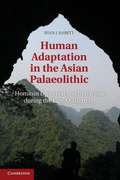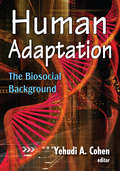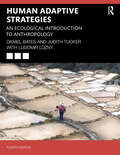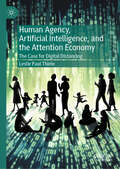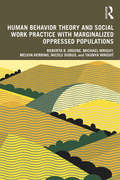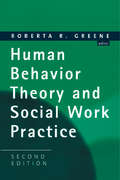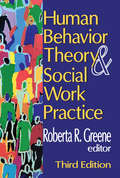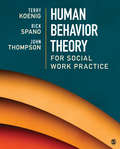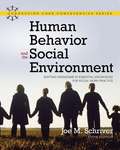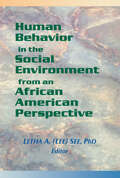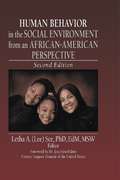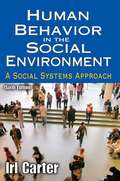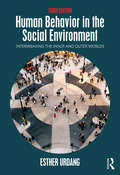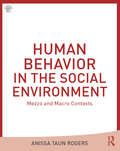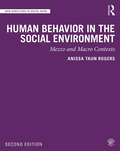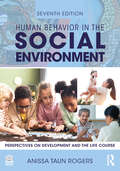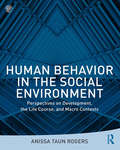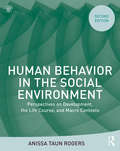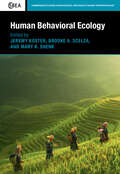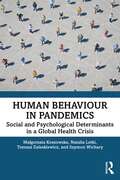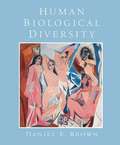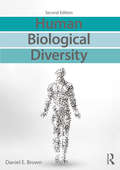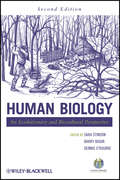- Table View
- List View
Human Adaptation in the Asian Palaeolithic
by Ryan J. RabettThis book examines the first human colonization of Asia and particularly the tropical environments of Southeast Asia during the Upper Pleistocene. In studying the unique character of the Asian archaeological record, it reassesses long-accepted propositions about the development of human 'modernity. ' Ryan J. Rabett reveals an evolutionary relationship between colonization, the challenges encountered during this process - especially in relation to climatic and environmental change - and the forms of behaviour that emerged. This book argues that human modernity is not something achieved in the remote past in one part of the world, but rather is a diverse, flexible, responsive, and ongoing process of adaptation.
Human Adaptation: The Biosocial Background
by Yehudi A. CohenUnderlying the anthropological study of humans is the principle that there is a reality to which a human must adapt for survival. Populations must adapt to the realities of the physical world and maintain a proper fit between their biological makeup and the pressures of the various niches of the world. Social groups must develop adaptive mechanisms in the organization of their social relations if there is to be order, regularity, and predictability in patterns of cooperation and competition. This book presents an introduction to anthropology that is unified and made systematic by its focus on adaptations that have accompanied the evolution of humans, from non-human primates to inhabitants of vast urban areas in modern industrial societies.Human Adaptation contains over forty outstanding essays that are intended to serve as an introduction to physical anthropology, archeology, and linguistics from the point of view of the processes of adaptation. The organization of these selections contains a balance between biological and prehistoric cultural adaptations. They provide coherence for the study of human evolution. Several selections, notably those in connection with linguistic adaptations, deal with contemporary people in order to shed light on earlier evolutionary processes. More than half of the selections deal with biological evolution.This volume unifies the subject matter of anthropology within a single and powerful explanatory framework and incorporates the work of the most renowned anthropological experts on man.
Human Adaptive Strategies: An Ecological Introduction to Anthropology
by Judith Tucker Daniel Bates Ludomir LoznyThis book introduces students to cultural anthropology with an emphasis on environmental and evolutionary approaches, focusing on how humans adapt to their environment and how the environment shapes culture. It shows how cultures evolve within the context of people’s strategies for surviving and thriving in their environments.This approach is widely used among scholars as a cross-disciplinary tool that rewards students with valuable insights into contemporary developments. Drawing on anthropological case studies, the authors address immediate human concerns such as the costs and consequences of human energy requirements, environmental change and degradation, population pressure, social and economic equity, and planned and unplanned change. Impacts of increasingly rapid climatic change on equitable access to resources and issues of human rights are discussed throughout. Towards the end of the book the student is drawn into a challenging thought experiment addressing the possible impacts of climatic warming on Middle America in the year 2040. All chapters conclude with "Summary," "Key Terms," and "Suggested Readings." This book is an ideal text for students of introductory anthropology and archaeology, environmental studies, world history, and human and cultural ecology courses.
Human Agency, Artificial Intelligence, and the Attention Economy: The Case for Digital Distancing
by Leslie Paul ThielePeople relish novelty, enjoy convenience, and are prone to distraction. These natural tendencies are now being dangerously exploited in the digital world. So we find ourselves bewitched by the shimmering screens of our digital devices, like moths circling a flame. It may only be a matter of time before our downward spiral reaches a deadly nadir. Leslie Paul Thiele incisively explores the psychological, social, and political impacts of social media, artificial intelligence, and digital platforms that are designed to capture our attention and maximize engagement. Digital technologies offer countless benefits. But in the attention economy, they also heighten distraction and dependence, erode cognitive and social skills, proliferate misinformation, amplify political polarization, increase social isolation, and leave us despondent. Governmental regulation is needed, but it cannot replace the individual’s responsibility to exercise self-governance. Thoroughly grounded in the latest scientific research but accessible to the general reader, this book explains how we can cultivate the dispositions, habits, and skills needed to sustain human agency and strengthen democratic prospects. In an age of incessant technological upgrading, Thiele demonstrates a vital and practical means to avert human downgrading.
Human Behavior Theory and Social Work Practice with Marginalized Oppressed Populations
by Michael Wright Roberta R. Greene Melvin Herring Nicole Dubus Taunya WrightHuman Behavior Theory and Social Work Practice with Marginalized Oppressed Populations addresses what social workers can do to combat the increasingly complex social concerns that face the profession, and explores how to incorporate the celebration of diversity and the protection of human rights into social work curricula and the helping process. The authors combine human behavior theories with a narrative, postmodern practice methodology that deals with both the client’s or constituencies’ presenting problem and equity issues, and, as a result, the book is both theoretical and applied. Two major integrating themes throughout are at the forefront of the book—the celebration of diversity and the equality of human rights. The goal is to strengthen diversity and human rights components of the social work curriculum and to provide more practice guidelines for cross-cultural practice.
Human Behavior Theory and Social Work Practice: Human Behavior Theory And Social Work Practice (Modern Applications Of Social Work Ser.)
by Roberta GreeneThis new edition of Human Behavior Theory and Social Work Practice provides a broadly synthetic approach to selecting theoretical concepts crucial to one's activities in casework. Centered on the notion of the client as an individual, Roberta Greene and the contributing authors examine the biological, psychological, and social aspects of development, and evaluate their utility for social work practice.Social work is characterized by a dynamic helping process and a diversity of roles, and functions. The aims of social work--to improve societal conditions for individuals, families, and groups--are put into action across all fields of practice and realized through a variety of methods in a range of settings. To work in the field, it is important to acquire conceptual frameworks that help one understand the complexities of contemporary practice. This volume is concerned with the application of knowledge about behavior in the social environment that serves as the theoretical underpinning for direct practice in social work. The chapters explore the ways in which specific theories have contributed to understanding the person in the environment construct and examine the idea that all clinical social work intervention is anchored in reshaping the context of the person in the environment configuration.The book explores the challenges and limitations of the various theories in use and addresses many relevant questions: What does the theory offer for understanding development across the lifecycle? What does each theory suggest about the interaction among biological, psychological, and sociocultural factors of human development and functioning? What does the theory suggest about healthy/functional and unhealthy/dysfunctional behaviors or wellness? Is theory universal in its application, and may it lend itself to cross-cultural social work practice? What role does theory propose for the social worker as an agent of change? Human Behavior Theory and Social Work Practice is an original contribution to social work theory, and will be mandatory reading for anyone pursuing a career in the field.
Human Behavior Theory and Social Work Practice: Human Behavior Theory And Social Work Practice (Modern Applications Of Social Work Ser.)
by Roberta R. GreeneHuman Behavior Theory and Social Work Practice remains a foundation work for those interested in the practice and teaching of social work. Roberta Greene covers theoretical areas and individual theorists including classical psychoanalytic thought, Eriksonian theory, Carl Rogers, cognitive theory, systems theory, ecological perspectives, social construction, feminism, and genetics. She discusses the historical context, its philosophical roots, and major assumptions of each theory. The general theme, which distinguishes this volume, is that the person-in-environment perspective has been a central influence in the formation of the profession's knowledge base, as well as its approach to practice. Greene provides perspective on how individuals and social systems interact.This book examines how social workers can use theory to shape social work practice by increasing his or her understanding of and potential for enhancing human well-being. Greene covers the relationship between human behavior theory and professional social work practice. She also explores the challenges and limitations of each theory and addresses the following issues: how the theory serves as a framework for social work practice; how the theory lends itself to an understanding of individual, family, group, community, or organizational behavior; what the implications are of the theory for social work interventions or practice strategies; and what role it proposes for the social worker as a change agent.Throughout the profession's history, social workers have turned to a number of theoretical approaches for the organizing concepts needed to define their practice base. The aims of social work--to improve societal conditions and to enhance social functioning of and between individuals, families, and groups--are put into action across all fields of practice and realized through a variety of methods in a range of settings. This third edition, completely revised, represents a fundamental contribution to the field, and like its predecessors, will be widely used as a basic text.
Human Behavior Theory for Social Work Practice
by John B. Thompson Terry L. Koenig Richard (Rick) SpanoHuman Behavior Theory for Social Work Practice provides an in-depth examination of human behavior theories and helps students apply each theory to social work practice. Authors Terry Koenig, Rick Spano, and John Thompson cover a broad spectrum of theories—including ecological, psychological, and sociopolitical—before applying them to a wide range of case examples that represent different stages across the human lifespan. Drawing from their extensive knowledge and experience in social work practice and teaching, the authors also feature scholarly research and writing to support the understanding of the theoretical overview in each chapter.
Human Behavior Theory for Social Work Practice
by John B. Thompson Terry L. Koenig Richard (Rick) SpanoHuman Behavior Theory for Social Work Practice provides an in-depth examination of human behavior theories and helps students apply each theory to social work practice. Authors Terry Koenig, Rick Spano, and John Thompson cover a broad spectrum of theories—including ecological, psychological, and sociopolitical—before applying them to a wide range of case examples that represent different stages across the human lifespan. Drawing from their extensive knowledge and experience in social work practice and teaching, the authors also feature scholarly research and writing to support the understanding of the theoretical overview in each chapter.
Human Behavior and the Social Environment: Shifting Paradigms in Essential Knowledge for Social Work Practice (5th edition)
by Joe M. SchriverThis textbook offers a comparative examination of competing paradigms in the study of human behavior and the social environment. The text focuses at each system level on the need for multiple perspectives that respect the diversity of persons and environments with whom social workers interact.
Human Behavior in the Social Environment from an African American Perspective: Second Edition
by Letha A SeeIn Human Behavior in the Social Environment from an African American Perspective, leading black scholars come together to discuss complex human behavior problems faced by African Americans and to force the abandonment of conceptualization theories made without consideration of the Black experience. Challenging you to engage in different thinking and develop new theories for addressing the needs of African Americans, this book highlights the assets of black individuals, families, and communities and guides you through program interventions and public policies that strengthen and empower African Americans. You will learn to enhance your clients’coping strategies and resilience by factoring in their strengths rather than focusing on their weaknesses.Human Behavior in the Social Environment from an African American Perspective contextualizes community behavior patterns, gender roles, and changing contemporary identities to challenge your assumptions about African American culture and communities and convince you to rethink your intervention strategies and methods. To further help you fine-tune your service delivery, this book leads you through discussions on: help-seeking behaviors of young street males the association of sociocultural risk factors with suicides the use of emotive behavior therapy to help African Americans cope with the prospect of imminent death advocating for changes in institutions and systems which negatively impact the lives of the poor and the oppressed how social work has ignored one segment of the African American community--young girls in urban settings psychological consequences of coming of age in a hostile environmentSocial workers, community-based groups, policymakers, and other helping professionals owe it to their clients to shrug off culturally incompetent services and care. Using Human Behavior in the Social Environment from an African American Perspective as a guide, you will learn to redress your programs and policies with a sensitivity to the factors and mechanisms that maximize the buoyancy of disadvantaged groups over various stages of their life development.
Human Behavior in the Social Environment from an African-American Perspective: Second Edition
by Letha A SeeHuman Behavior in the Social Environment from an African-American Perspective, Second Edition is an updating of the classic text that presents leading black scholars discussing complex human behavior problems faced by African-Americans in today’s society. This new edition provides fresh theories and the latest practical interventions not in the first edition that show, for example, how to enhance a client’s coping strategies and resilience by focusing on their strengths rather than their weaknesses. This edition includes a new foreword by former Surgeon General, Dr. Joycelyn Elders.Human Behavior in the Social Environment from an African-American Perspective, Second Edition acquaints practitioners with the Black experience, and provides the latest innovative methods of working with this diverse population. This edition also offers new insights on evaluating practice initiatives. Experts and scholars explore and interpret individual and group behaviors, the strength and resilience of the black family, the stresses and problems affecting children, the significant problem of the affects of colorism, the self-esteem and identity issues of biracial children, violence in the criminal justice system, the HIV/AIDS pandemic, the stress and behaviors resulting from belonging to the armed services, and other behavior stemming from progression through the life cycle. Chapters include charts and tables of data, extensive references, and study questions for deeper study for students.Topics in Human Behavior in the Social Environment from an African-American Perspective, Second Edition include: the importance of the consideration of the black experience in analyzing black behavior behavior as a response to a hostile social system the black church’s role in leading African-Americans resiliency perspective as a positive force the use of strength behaviors for socialization and survival strategies to strengthen roles of fathers in African-American families military culture as a microcosm of the wider society the psychological effects of skin color on self-esteem the No Child Left Behind Act of 2001 and its effects refreshing social work practice to better meet the needs of African-American girls examination of a study on the help-seeking behaviors of young African-American males empirically based creative intervention strategies to alleviate black-on-black crime analysis of street gang behaviors with a program to address it influences of hip hop culture strategies to lessen substance abuse in children practices that help assist administrators and social workers to lessen school violenceHuman Behavior in the Social Environment from an African-American Perspective, Second Edition is a supplementary text that is valuable for undergraduate and graduate students, human service practitioners, mental health and medical counselors, policymakers, school officials, and criminal justice personnel.
Human Behavior in the Social Environment: A Social Systems Approach (Sixth Edition)
by Irl CarterSince the publication of the first edition of Human Behavior in the Social Environment, several generations of students have successfully used this classic text, which takes a social systems approach to human behavior. This systems approach is still widely accepted in the human services disciplines, including social work, education, nursing, psychology, and in human services programs themselves. Its ideas have become the organizing framework for curriculum, as well as fruitful sources for new applications of theory and practice. Among the advantages of the social systems approach is that it permits students and practitioners to see connections between fields of practice, between methods, and across professional disciplines and bodies of theory. The book serves as a template of the concentric circles of human behavior, with chapters on fields of behavior, beginning with the person and ranging outward to culture and society. Abundant examples from practice and from behavioral patterns are drawn from the social sciences, topical events, literature, and the authors’ personal and professional experiences. This volume responds to the needs of students and instructors as these have developed since the publication of the previous edition.
Human Behavior in the Social Environment: Interweaving the Inner and Outer Worlds
by Esther UrdangHuman Behavior in the Social Environment: Interweaving the Inner and Outer Worlds is an essential human behavior textbook for social work students. The third edition emphasizes the biopsychosocial framework within a psychodynamic, developmental and life-course perspective and includes a brand new chapter on the psychosocial complexities of technological advances. Written by an experienced classroom teacher, faculty advisor and clinician, the text approaches development through the life cycle, discussing the challenges, tasks, and problems of each stage. Presenting complex concepts in a clear and understandable way, Human Behavior in the Social Environment: Includes 16 chapters which cover the diverse nature of the circumstances that practicing social workers will be exposed to, including cultural differences, mental health issues, and disability; Analyses several different theories, including psychoanalytic, ego psychology, cognitive-behavioral, and postmodern theories in a manner that enables students to engage critically with the subject matter; Includes case vignettes and material from literary works, biographies and newspapers, intertwined with learning exercises and suggestions for additional readings, forming an engaging and practical volume. Written specifically for social work students undertaking courses and modules on human behavior in the social environment, this book is also a valuable resource for beginning and advanced readers in human services, including nursing, medicine, public health, clinical psychology and counseling.
Human Behavior in the Social Environment: Mezzo and Macro Contexts
by Anissa Taun RogersThis addition to Anissa Rogers' bestselling Human Behavior in the Social Environment expands the original text with new chapters on spirituality, families and groups, organizations, and communities. Written in the compact, concise manner of the original text, the new chapters cover mezzo and macro contexts, and offer additional material valuable to two- and three-semester HBSE courses.
Human Behavior in the Social Environment: Mezzo and Macro Contexts
by Anissa Taun RogersThis addition to Anissa Rogers' bestselling Human Behavior in the Social Environment expands the original text with new chapters on spirituality, families and groups, organizations, and communities. Written in the compact, concise manner of the original text, the new chapters cover mezzo and macro contexts, and offer additional material valuable to two- and three-semester HBSE courses. These new supplemental chapters provide instructors with an opportunity to choose the chapters that best fit the layout of the course: Instructors can use all four new chapters with the core HBSE text; or they may choose one or several to augment the core HBSE text, allowing the text to be customized to the way in which the course is taught. Along with the bestselling core HBSE text, these supplemental chapters are ideal for use in either one-semester or year-long generalist human behavior courses. Why? Because the combined texts are concise and easily used in a one-semester course. But the combined texts also come with a companion set of readings and six unique cases that encourage your students to learn by doing and to apply their knowledge of human behavior to best practices. Go to www.routledgesw.com/hbse to learn more. These additional resources easily allow you to use the text (and its related resources) in a two-semester sequence.
Human Behavior in the Social Environment: Perspectives on Development and the Life Course (New Directions in Social Work)
by Anissa RogersHuman Behavior in the Social Environment: Perspectives on Development and the Life Course returns for a seventh edition to provide students with an expansive overview of the major theories and issues related to human behavior and the social environment that are important to understand for professional practice across a variety of cases and contexts.Maintaining its clarity and cohesion, this edition has been updated to offer students current and relevant information on important topics in social work practice and expanded to help students understand the complexity of the issues they will face in the field, including how poverty, diversity, and strengths affect human development and behavior. Several new theoretical perspectives appear in this update, including indigenous theory, new feminism, and restorative justice, and these additions complement the major psychological, sociological, life course, and anti-oppressive theories that have come to define this book’s grounded and balanced coverage.Illustrated and fully supported by a set of Quick Guides for students engaged in field work, vignettes woven throughout the book, and a full package of interactive cases and instructor-led resources that are available on www.routledgesw.com, the new edition of Human Behavior in the Social Environment is a perfect complement to this foundation course on the undergraduate and graduate level. Its signature theoretical framework equips students to have a well-rounded understanding to call upon and apply to the myriad client problems and situations they will need to practice social work.
Human Behavior in the Social Environment: Perspectives on Development, the Life Course, and Macro Contexts
by Anissa Taun RogersIn this book and companion custom website you will find: • A comprehensive overview of the issues related to human behavior and the social environment that are important to understand for practice, updated with current and relevant information on important topics in social work. Additional relevant content, contemporary theories, and intervention modalities are incorporated throughout the text to keep students up to date with what is happening in the field.• Careful organization of chapters to first present foundational theoretical perspectives on the human condition, and then provide information on basic facets of human development, encouraging students to use conceptual lenses to inform their practice with individuals at different stages of life. Four final chapters cover theoretical foundations and issues surrounding spirituality, families and groups, organizations, and communities. These chapters offer in-depth information and discussions on mezzo and macro content. The organization of the chapters also helps students better understand how contemporary theories and approaches to issues stem from foundational theories and how they can be used to inform work with clients. • Particular emphasis on the ways in which poverty, diversity, and strengths affect human development and behavior.• The opportunity to see how the concepts fit into social work practice using case examples that open each chapter and are referred to throughout the chapter.• Interactive case studies at www.routledgesw.com/cases: Six easy-to-access fictional cases with dynamic characters and situations that students can easily reach from any computer and that provide a “learning by doing” format unavailable with any other text. Your students will have an advantage unlike any other they will experience in their social work training.• A wealth of instructor-only resources at www.routledgesw.com/hbse that provide full-text readings that link to the concepts presented in each of the chapters; a complete bank of objective and essay-type test items, all linked to current CSWE EPAS (Council on Social Work Education Educational Policy and Accreditation Standards); PowerPoint presentations to help students master key concepts; annotated links to a treasure trove of social work assets on the Internet; and a forum inviting all instructors using books in the series to communicate with each other and share ideas to improve teaching and learning.• Ideal for use in online as well as hybrid course instruction—in addition to traditional “bricks and mortar” classes. This bestseller is ideal for use in either one-semester or year-long generalist human behavior courses. Why? Because the text is concise and easily used in a one-semester course. But the text also comes with a companion set of readings, additional chapters focused on macro social work, and six unique cases that encourage your students to “learn by doing” and to apply their knowledge of human behavior to best practices. Go to www.routledgesw.com/hbse to learn more. These additional resources easily allow you to use the text (and its related resources) in a two-semester sequence.
Human Behavior in the Social Environment: Perspectives on Development, the Life Course, and Macro Contexts
by Anissa Taun RogersIn this new aggregated edition of Anissa Taun Roger’s Human Behavior in the Social Environment, readers will find a comprehensive overview of the issues related to human behavior and the social environment. Chapters are organized to first present foundational theoretical perspectives on the human condition, and then provide information on the basic facets of human development, encouraging students to use conceptual lens to inform their practice with individuals at different stages of life. The four final chapters cover theoretical frameworks and approaches to four areas of macro concern: spirituality, families and groups, organizations, and communities. Through this section, students will understand how contemporary theories and approaches build from foundational perspectives, and how they in turn can be used to inform their work with clients. In this edition and updated companion website, readers will also find: Particular emphasis on the ways in which poverty, diversity, and strengths affect human development and behavior The opportunity to see how the concepts fit into social work practice using chapter opening case examples that are referred to throughout the chapter. Interactive case studies at www.routledgesw.com/cases: Six easy-to-access fictional cases with dynamic characters and situations that students can easily reach from any computer and that provide a "learning by doing" format unavailable with any other text. Your students will have an advantage unlike any other they will experience in their social work training. A full library of instructor-only resources at www.routledgesw.com/hbse that provide full-text readings that connect to the concepts presented in each of the chapters; a complete bank of objective-based and essay-type test items, all linked to current CSWE EPAS (Council on Social Work Education Educational Policy and Accreditation Standards); PowerPoint presentations to help students master key concepts; annotated links to a treasure trove of social work assets on the Internet; and a forum inviting all instructors using books in the series to communicate with each other and share ideas to improve teaching and learning.
Human Behavioral Ecology (Cambridge Studies in Biological and Evolutionary Anthropology)
by Jeremy Koster Brooke A. Scelza Mary K. ShenkHuman behavioral ecology (HBE) applies the principles of evolutionary theory and optimisation to the study of human behavioural and cultural diversity. Among other things, HBE attempts to explain variation in behaviour as adaptive solutions to the competing life-history demands of growth, development, reproduction, parental care, and mate acquisition. This book is a comprehensive introduction to the theoretical orientation and specific findings of HBE. It consolidates the insights of evolution and human behaviour into a single volume that reflects the current state and future of the field. It brings together leading scholars from across the evolutionary social sciences to provide a comprehensive and thought-provoking review of the state of the topic. Throughout, the authors explain the latest developments in theory and highlight critical debates in the literature, while also engaging readers with ethnographic insights and field-based studies that remain at the core of human behavioral ecology.
Human Behaviour in Pandemics: Social and Psychological Determinants in a Global Health Crisis
by Malgorzata Kossowska Tomasz Zaleskiewicz Natalia Letki Szymon WicharyThis timely interdisciplinary book brings together a wide spectrum of theoretical concepts and their empirical applications in relation to the COVID-19 pandemic, informing our understanding of the social and psychological bases of a global crisis. Written by an author team of psychologists and sociologists, the volume provides comprehensive coverage of phenomena such as fear, risk, judgement and decision making, threat and uncertainty, group identity and cohesion, social and institutional trust, and communication in the context of an international health emergency.The topics have been grouped into four main chapters, focusing on the individual, group, social, and communication perspectives of the issues affecting or being affected by the pandemic, based on over 740 classic and current references of peer-reviewed research and contextualized with an epidemiological perspective discussed in the introduction. The volume finishes with two special sections, with a chapter on cultural specificity of the social impact of pandemics, focusing specifically on both Islam and Hinduism, and a chapter on the cross-national differences in policy responses to the current health crisis. Providing not just a reference for academic research, but also short-term and long-term policy solutions based on successful strategies to combat adverse social, cognitive, and emotional consequences, this is the ideal resource for academics and policymakers interested in social and psychological determinants of individual reactions to pandemics, as well as in fields such as economics, management, politics, and medical care.
Human Biodiversity: Genes, Race, and History
by Jonathan MarksAre humans unique? This simple question, at the very heart of the hybrid field of biological anthropology, poses one of the false of dichotomies—with a stereotypical humanist answering in the affirmative and a stereotypical scientist answering in the negative.The study of human biology is different from the study of the biology of other species. In the simplest terms, people's lives and welfare may depend upon it, in a sense that they may not depend on the study of other scientific subjects. Where science is used to validate ideas—four out of five scientists preferring a brand of cigarettes or toothpaste—there is a tendency to accept the judgment as authoritative without asking the kinds of questions we might ask of other citizens' pronouncements.In Human Biodiversity, Marks has attempted to distill from a centuries-long debate what has been learned and remains to be learned about the biological differences within and among human groups. His is the first such attempt by an anthropologist in years, for genetics has undermined the fundamental assumptions of racial taxonomy. The history of those assumptions from Linnaeus to the recent past—the history of other, more useful assumptions that derive from Buffon and have reemerged to account for genetic variation—are the poles of Marks's exploration.
Human Biological Diversity
by Daniel E. BrownThis text is intended for the sophomore level course in human variation/human biology taught in anthropology departments. It may also serve as a supplementary text in introductory physical anthropology courses.In addition to covering the standard topics for the course, it features contemporary topics in human biology such as the Human Genome Project, genetic engineering, the effects of stress, obesity and pollution.
Human Biological Diversity
by Daniel E. BrownHuman Biological Diversity is an introductory textbook designed to cover the key contemporary topics in the study of human variation and human biology within the field of physical anthropology. Easily accessible for students with no background in anthropology or biology, this second edition includes two new chapters, one on human variation in the skeleton and dentition and the other on tracing human population affinities. All other chapters have been fully updated to reflect advances in the field and now include pedagogical features to aid readers in their understanding. Written for an introductory level but still containing valuable information that will be of interest to students on upper-level courses, Brown’s textbook should be essential reading for all students taking courses on human variation, human biology, human evolution, race, anthropology of race, and general introductions to biological/physical anthropology.
Human Biology
by Sara StinsonThis comprehensive introduction to the field of human biology covers all the major areas of the field: genetic variation, variation related to climate, infectious and non-infectious diseases, aging, growth, nutrition, and demography. Written by four expert authors working in close collaboration, this second edition has been thoroughly updated to provide undergraduate and graduate students with two new chapters: one on race and culture and their ties to human biology, and the other a concluding summary chapter highlighting the integration and intersection of the topics covered in the book.
